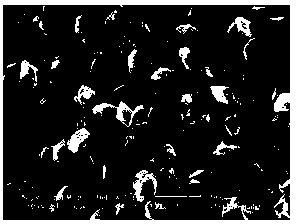Method for adjusting and controlling structure and shape of calcium oxalate crystals by using colibacillus secretion
A technology of Escherichia coli and crystal structure, applied in the field of biochemistry, can solve the problem that there is no ideal method for stone prevention, and achieve the effect of consistent shape, high conversion rate and simple steps
- Summary
- Abstract
- Description
- Claims
- Application Information
AI Technical Summary
Problems solved by technology
Method used
Image
Examples
Embodiment 1
[0025] Preparation of E. coli secretions:
[0026] Pick a single colony of Escherichia coli TOP10 preserved at 4°C, inoculate it in LB liquid medium, place it in a oscillating water bath with a constant temperature of 37.5°C and shake it at 110 rpm for 24 hours to obtain the original bacterial liquid, and centrifuge the original bacterial liquid at 4000 rpm to obtain the secretion of E. coli were stored at 4°C for later use.
[0027] Preparation of non-calculus calcium oxalate dihydrate crystals:
[0028] Prepare 100mM calcium chloride and 5mM sodium oxalate solutions respectively. Take 40ml of calcium chloride solution with a concentration of 100mM in a 100ml Erlenmeyer flask, add 10ml of Escherichia coli secretion, then add 40ml of sodium oxalate with a concentration of 5mM into the Erlenmeyer flask, shake it and place it in a constant temperature incubator at 37.5°C 24 hours. The supernatant was discarded, and the bottom crystals were washed twice with water and ethanol ...
Embodiment 2
[0030] The preparation of Escherichia coli secretion was the same as in Example 1.
[0031] Prepare 100mM calcium chloride and 5mM sodium oxalate solutions respectively. Take 40ml of calcium chloride solution with a concentration of 100mM in a 100ml Erlenmeyer flask, add 1ml of Escherichia coli secretion, and then add 40ml of sodium oxalate with a concentration of 5mM into the Erlenmeyer flask. After shaking, place it in a constant temperature incubator at 37.5°C for 24 hours. The supernatant was discarded, and the crystals at the bottom were washed with water and ethanol twice respectively. The resulting sample ( Figure 4 ) placed in an evaporating dish and dried at room temperature and then stored in a sample tube. The measured percentage of calcium oxalate dihydrate is 15%, and the rest is calcium oxalate monohydrate crystals, indicating that a very small amount of Escherichia coli secretion has a control effect on the crystal form of calcium oxalate.
Embodiment 3
[0033] The preparation of Escherichia coli secretion was the same as in Example 1.
[0034] Prepare 100mM calcium chloride and 5mM sodium oxalate solutions respectively. Take 40ml of calcium chloride solution with a concentration of 100mM in a 100ml Erlenmeyer flask, add 5ml of Escherichia coli secretion, and then add 40ml of sodium oxalate with a concentration of 5mM into the Erlenmeyer flask. After shaking, place it in a constant temperature incubator at 37.5°C for 24 hours. The supernatant was discarded, and the crystals at the bottom were washed with water and ethanol twice respectively. The resulting sample ( Figure 5 ) placed in an evaporating dish and dried at room temperature and then stored in a sample tube. The measured percentage of calcium oxalate dihydrate was 43.4%, and the rest was calcium oxalate monohydrate crystals, indicating that the crystallization ratio of calcium oxalate dihydrate increased with the increase in the amount of E. coli secretion.
PUM
 Login to View More
Login to View More Abstract
Description
Claims
Application Information
 Login to View More
Login to View More - R&D
- Intellectual Property
- Life Sciences
- Materials
- Tech Scout
- Unparalleled Data Quality
- Higher Quality Content
- 60% Fewer Hallucinations
Browse by: Latest US Patents, China's latest patents, Technical Efficacy Thesaurus, Application Domain, Technology Topic, Popular Technical Reports.
© 2025 PatSnap. All rights reserved.Legal|Privacy policy|Modern Slavery Act Transparency Statement|Sitemap|About US| Contact US: help@patsnap.com



